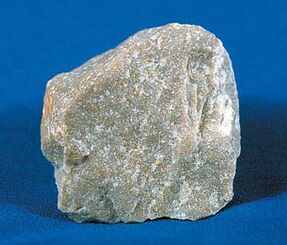Quartzite
Quartzite forms from the metamorphic recrystallization of quartz-rich sandstone. The mineral quartz interlocks and deforms due to its subjection to heat and pressure. This creates a hard rock completely made up from quartz crystals and has a glassy look.
Origin
Quartzite forms at convergent plate boundaries where it is exposed to regional metamorphism. This can be done by heat and pressure over a longer time most of the times when a plates collide and rocks are burried deep into the crust. Before it is metamorphosed the sandstone consist of sand grains and silica cement. This cement and grains reform during metamorphism creating a whole other texture and a very hard rock. Quartzite is the base for large mountain ranges because of its physical durability and chemical resistance.
Characteristics
Quartzite has a lot similarities with is parent rock: the sandstone. They can't be distinguished on there appearance at most at the fact that sandstone has traces of chemical weathering and quartzite has a few to none. They can be held apart by their hardness. Quartzite is very hard and will often break on the quartz crystals itself than on the borders between the crystals in contrary to sandstone.
Quartzite is usually white to gray in color. Some rock units that are stained by iron can be pink, red, or purple. Other impurities can cause quartzite to be yellow, orange, brown, green, or blue.[1]
Quartzite is also a poor soil-former. Unlike feldspars which break down to form clay minerals, the weathering debris of quartzite is quartz. It is therefore not a rock type that contributes well to soil formation. For that reason it is often found as exposed bedrock with little or no soil cover.[2]
References
- https://geology.com/
- NEN-EN-ISO 14688-1:2019
Quartzite

| Type | Metamorphic rock |
|---|---|
| Luster | Glassy |
| Clasts | Fine |
| Hardness | Very hard |
| Color | Depends on parent rock |
| Minerals | Quartz |
| Touch | Rough |
| Image | Quartzite |